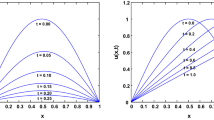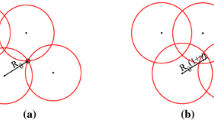Abstract
In this paper, a localized radial basis function (RBF) method is applied to obtain a global approximation of the solution of two dimensional Klein-Gordon equation on a given bounded domain. We use the RBF partition of unity (RBF-PU) method which is based on partitioning the original domain to several patches and using the RBF approximation on each local domain. Low computational cost and well conditioned final linear system are the main advantages of this method comparing with the original (global) RBF techniques. Numerical experiments show that the given problem could be solved successfully with a reasonable accuracy.













Similar content being viewed by others
Change history
13 November 2020
A Correction to this paper has been published: https://doi.org/10.1007/s00366-020-01213-6
References
Argyris J, Haase M, Heinrich JC (1991) Finite element approximation to two-dimensional sine-gordon solitons. Comput Methods Appl Mech Eng 86:1–26
Bogolyubskiǐ IL (1976) Oscillating particle-like solutions of the nonlinear Klein-Gordon equation. JETP Lett 24(10):535–538
Bogolyubskiǐ IL (1977) Dynamics of spherically symmetrical pulsons of large amplitude. JETP Lett 25(2):107–110
Bogolyubskiǐ IL, Makhankov VG (1976) Lifetime of pulsating solitons in certain classical models. JETP Lett 24(1):12–14
Bratsos AG (2007) The solution of the two-dimensional sine-gordon equation using the method of lines. J Comput Appl Math 206:251–277
Bratsos AG (2007) A third order numerical scheme for the two-dimensional sine-gordon equation. Math Comput Simul 76:271–282
Christiansen PL, Lomdah PS (1981) Numerical study of \(2+1\) dimensional sine-gordon solitons. Physica 2D(3):482–491
Darani MA (2017) Direct meshless local Petrov-Galeckin method for the two-dimensional klein-gordon equation. Eng Anal Bound Elem 74:1–13
Davydov AS (1976) Quantum mechanics. Pergamon, Elmsford
Davydov O, Schaback R (2017) Optimal stencils in Sobolev spaces. IMA J Numer Anal 39(1):398–422
Djidjeli K, Price WG, Twizell EH (1995) Numerical solutions of a damped sine-gordon equation in two space variables. J Eng Math 29:347–369
Drazin PG, Johnson RS (1983) Solitons: an introduction. Cambridge University Press, Cambridge
Ebaid A (2009) Exact solutions for the generalized Klein-Gordon equation via a transformation and Exp-function method and comparison with Adomian’s method. J Comput Appl Math 223:278–290
Floater MS, Iske A (1996) Multistep scattered data interpolation using compactly supported radial basis functions. J Comput Appl Math 73:65–78
Fornberg B, Larsson E, Flyer N (2011) Stable computations with Gaussian radial basis functions. SIAM J Sci Comput 33:869–892
Guo BY, Pascual PJ, Rodriguez MJ, Vzquez L (1986) Numerical solution of the sine-gordon equation. Appl Math Comput 18:1–14
Heryudono A, Larsson E, Ramage A, Von Sydow L (2016) Preconditioning for radial basis function partition of unity methods. J Sci Comput 67:1089–1109
Iske A (2002) On the approximation order and numerical stability of local lagrange interpolation by polyharmonic splines. Mod Dev Multivar Approx 145:153–165
Kivshar Yu S, Malomed BA (1989) Dynamics of solitons in nearly integrable systems. Rev Mod Phys 61:763–915
Larsson E, Lehto E, Heryudono ARH, Fornberg B (2013) Stable computation of differentiation matrices and scattered node stencils based on gaussian radial basis functions. SIAM J Sci Comput 35:1–22
Larsson E, Shcherbakov V, Heryudono A (2017) A least squares radial basis function partition of unity method for solving PDEs. SIAM J Sci Comput 39:538–563
Malomed BA (1987) Decay of shrinking solitons in multidimensional sine-gordon equation. Phys D 24(1):155–171
Melenk JM, Babuska I (1996) The partition of unity finite element method: basic theory and applications. Comput Meth Appl Mech Eng 139:289–314
Mirzaei D, Dehghan M (2009) Boundary element solution of the two-dimensional sine-gordon equation using continuous linear elements. Eng Anal Bound Elem 33:12–24
Mirzaei D, Dehghan M (2009) Implementation of meshless LBIE method to the 2D nonlinear SG problem. Int J Numer Meth Eng 79:1662–1682
Mirzaei D, Dehghan M (2010) Meshless local Petrov-Galerkin (MLPG) approximation to the two dimensional sine-Gordon equation. J Comput Appl Math 233:2737–2754
Safdari-Vaighani A, Heryudono A, Larsson E (2015) A radial basis function partition of unity collocation method for convection-diffusion equations arising in financial applications. J Sci Comput 64:341–367
Schaback R (1995) Creating surfaces from scattered data using radial basis functions. Mathematical methods for curves and surfaces. University Press, Oxford, pp 477–496
Shepard D (1968) A two-dimensional interpolation function for irregularly-spaced data. In Proceedings of the 23th National Conference ACM, pp. 517–523
Shokri A, Dehghan M (2010) A not-a-knot meshless method using radial basis functions and predictor-corrector scheme to the numerical solution of improved boussinesq equation. Comput Phys Commun 181:1990–2000
Shokri A, Dehghan M (2012) Meshless method using radial basis functions for the numerical solution of two-dimensional complex ginzburg-landau equation. CMES-Comput Model Eng Sci 84:333–358
Stevens D, Power H, Meng CY, Howard D, Cliffe KA (2013) An alternative local collocation strategy for high-convergence meshless pde solutions using radial basis functions. J Comput Phys 254:52–75
Wendland H (1998) Error estimates for interpolation by compactly supported radial basis functions of minimal degree. J Approx Theory 93:258–272
Wendland H (2002) Fast evaluation of radial basis functions: methods based on partition of unity. Approximation theory X: wavelets, splines and applications. Vanderbilt University Press, Nashville, pp 473–483
Wendland H (2005) Scattered data approximation. Cambridge University Press, Cambridge
Wendland H (2010) Multiscale analysis in Sobolev spaces on bounded domains. Numer Math 116:493–517
Acknowledgements
Special thanks go to Dr. Davoud Mirzaei for his helpful comments and suggestions that improved the quality of the paper. Supports from IPM-Isfahan are greatly acknowledged. The author is very grateful to reviewers for carefully reading this paper and for their comments and suggestions which have improved the paper.
Author information
Authors and Affiliations
Corresponding author
Additional information
Publisher's Note
Springer Nature remains neutral with regard to jurisdictional claims in published maps and institutional affiliations.
The original version of this article was revised due to a retrospective Open Access cancellation
Electronic supplementary material
Below is the link to the electronic supplementary material.
Rights and permissions
About this article
Cite this article
Ahmadi Darani, M. The RBF partition of unity method for solving the Klein-Gordon equation. Engineering with Computers 38 (Suppl 1), 679–691 (2022). https://doi.org/10.1007/s00366-020-01171-z
Received:
Accepted:
Published:
Issue Date:
DOI: https://doi.org/10.1007/s00366-020-01171-z




